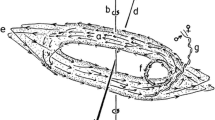Abstract
Locusts exhibit two basic forms or phases, one characteristic of swarming populations, termed phase gregaria, and the other characteristic of low density populations, termed phase solitaria. It has been claimed by Nolte that locusts living at low density, both in the field and in the laboratory, have a reduced chiasma frequency compared with animals living at high density. A postulated gregarisation pheromone is held to be responsible for the stimulation of melanin biosynthesis in the swarming animals and an unknown metabolite in this pathway causes the increase in chiasma frequency, as well as other phenotypic changes associated with phase transformation. According to Nolte this represents a means of releasing stored genetic variation necessary for adaptation in the areas invaded by swarms. — This claim has been re-examined in laboratory stocks of Schistocerca gregaria using a methodology comparable to that of Nolte. No reduction in the chiasma frequency of isolated animals was observed in any of the experiments. The isolated animals did, however, develop a phenotype characteristic of phase solitaria in terms of their pigmentation and morphometrics.
Similar content being viewed by others

References
Albrecht, F. O.: Some physiological and ecological aspects of locust phases. Trans. roy. ent. Soc. Lond. 114, 335–375 (1962)
Albrecht, F. O.: Polymorphisme phasaire et biologie des Acridiens migrateurs. Paris: Masson et Cie 1967
Albrecht, F. O., Verdier, M., Blackith, R. E.: Maternal control of ovariole number in the progeny of the Migratory Locust. Nature (Lond.) 184, 103–104 (1959)
Blackith, R. E.: Morphometrics in acridology: a brief survey. Acrida (Paris) 1, 7–15 (1972)
Dirsh, V. M.: Morphometrical studies on phases of the Desert Locust (Schistocerca gregaria Forskål). Anti-Locust Bull. (Lond.) 16 (1953)
Dudley, B. A. C.: The effects of temperature and humidity upon certain morphometric and colour characters of the Desert Locust (Schistocerca gregaria Forskål) reared under controlled conditions. Trans, roy. ent. Soc. Lond. 116, 115–129 (1964)
Ellis, P. E.: Learning and social aggregation in locust hoppers. Anim. Behaviour 7, 91–106 (1959a)
Ellis, P. E.: Some factors influencing phase characters in the nymphs of the locust, Locusta migratoria migratorioides (R. et F.). Insectes sociaux 6, 21–39 (1959b)
Ellis, P. E.: The behaviour of locusts in relation to phases and species. Colloq. int. Cent. nat. Rech. sci. 114, 123–143 (1962)
Ellis, P. E.: Phase variation in locusts in relation to heredity and rearing conditions. Proc. Int. Study Conf. Current and Future Problems of Acridology, London 1970, p. 63–77 (1972)
Gillet, S.: Airborne factor affecting the grouping behaviour of locusts. Nature (Lond.) 218, 782–783 (1968)
Goodwin, T. W.: The biochemistry of locust pigmentation. Biol. Rev. 27, 439–460 (1952)
Gunn, D. L., Hunter-Jones, P.: Laboratory experiments on phase differences in locusts. Anti-Locust Bull. 12 (1952)
Hunter-Jones, P.: Laboratory studies on the inheritance of phase characters in locusts. Anti-Locust Bull. 29 (1958)
Husain, M. A., Ahmad, T.: Studies on Schistocerca gregaria Forsk. VI. Influence of temperature on the intensity and extent of black pattern in the Desert Locust hoppers bred crowded. Indian J. agric. Sci. 6, 624–664 (1936)
Husain, M. A., Mathur, C. B.: Studies on Schistocerca gregaria Forsk. XL The influence of temperature on the growth in weight and size of the hoppers. Indian J. Ent. 5, 107–115 (1944)
Kennedy, J. S.: Phase transformation in locust biology. Biol. Rev. 31, 349–370 (1956)
Kennedy, J. S.: Continuous polymorphism in locusts. 1st Symp. roy. ent. Soc. Lond. 1961, 80–90 (1961)
Nolte, D. J.: A pheromone for melanization of locusts. Nature (Lond.) 200, 660–661 (1963)
Nolte, D. J.: The nuclear phenotype of locusts. Chromosoma (Berl.) 15, 367–388 (1964a)
Nolte, D. J.: Chiasma formation and gregarization in locusts. Nature (Lond.) 204, 1110–1111 (1964b)
Nolte, D. J.: Genetic recombination in the African Migratory Locust. Proc. 3rd Congr. S. Afr. genet. Soc. (Pretoria) p. 23–26, 1966
Nolte, D. J.: Phase transformation and chiasma formation in locusts. Chromosoma (Berl.) 21, 123–139 (1967)
Nolte, D. J.: The chiasma-inducing pheromone of locusts. Chromosoma (Berl.) 23, 346–358 (1968 b)
Nolte, D. J.: Chiasma-induction and tyrosine metabolism in locusts. Chromosoma (Berl.) 26, 287–297 (1969)
Nolte, D. J.: The gregarisation pheromone. Proc. Int. Study Conf. Current and Future Problems of Acridology, London 1970, p. 85–92 (1972)
Nolte, D. J., Desi, I., Meyers, B.: Genetic and environmental factors affecting chiasma formation in locusts. Chromosoma (Berl.) 27, 145–155 (1969)
Nolte, D. J., May, I. R., Thomas, B. M.: The gregarisation pheromone of locusts. Chromosoma (Berl.) 29, 462–473 (1970)
Rainey, R. C.: Some effects of environmental factors on movements and phase-change of locust populations in the field. Colloq. int. Cent. nat. Rech. sci. 114, 175–189 (1962)
Rowell, C. H. F.: The variable coloration of the Acridoid grasshoppers. Advanc. Insect Physiol. 8, 145–198 (1971)
Shaw, D. D.: Genetic and environmental components of chiasma control. I. Spatial and temporal variation in Schistocerca and Stethophyma. Chromosoma (Berl.) 34, 281–301 (1971)
Sokal, R. R., Rohlf, F. J.: Biometry. The principles and practice of statistics in biological research. San Francisco: H. W. Freeman & Co. 1969
Stower, W. J.: The colour patterns of hoppers of the Desert Locust (Schistocerca gregaria Forskål). Anti-Locust Bull. (Lond.) 32 (1959)
Uvarov, B. P.: A revision of the genus Locusta, L. (=Pachytylus, Fieb.) with a new theory as to the periodicity and migration of locusts. Bull. ent. Res. 12, 135–163 (1921)
Uvarov, B. P.: The aridity factor in the ecology of locust and grasshoppers of the Old World. In: Arid zone research. VIII. Human and animals ecology, Reviews of research, p. 164–198. Paris 1957
Uvarov, B. P.: Grasshoppers and locusts. A handbook of general acridology, volume 1. London: Cambridge University Press 1966.
Author information
Authors and Affiliations
Rights and permissions
About this article
Cite this article
Dearn, J.M. Phase transformation and chiasma frequency variation in locusts. Chromosoma 45, 321–338 (1974). https://doi.org/10.1007/BF00283414
Received:
Issue Date:
DOI: https://doi.org/10.1007/BF00283414



